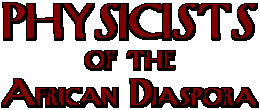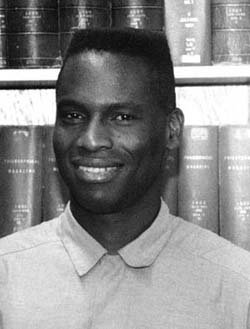

Philip Phillips

born:
place: Scarborough, Tobago
![]() B.S. (chemistry
and mathematics) Walla Walla College (1979 )
B.S. (chemistry
and mathematics) Walla Walla College (1979 )
![]() PhD (Physical Chemisrty)
University of Washington (1982)
PhD (Physical Chemisrty)
University of Washington (1982)
![]() . Full Professor
of Physics, Department of Physics University of Illinois at Urbana-Champaign
. Full Professor
of Physics, Department of Physics University of Illinois at Urbana-Champaign
URL: http://www.physics.uiuc.edu/People/Faculty/profiles/Phillips/
email: dimer@uiuc.edu
Dr. Phillips was a Miller Fellow at the University of California, Berkeley, from 1982 to 1984, when he joined the Chemistry Department at the Massachusetts Institute of Technology. He came to Illinois from MIT in 1993.
Awards
Beckman Associate, Center for Advanced Study, 1999
Senior Xerox Faculty Award 1998
American Physical Society Bouchet Award 2000
2003 elected Fellow for "Creative theoretical contributions
to the the studies of strongly correlated electronic systems including
the random dimer model and superconductor-insulator transitions."
He was nominated by DCMP (Condensed Matter).
Research
His research in theoretical condensed matter physics confronts experimental observations that challenge the standard paradigms of transport and magnetism in disordered and correlated electron systems. Much of his recent work has been devoted to explaining the origin of the new conducting phase found in a dilute 2D electron gas.
Local Pairing at U-Impurities in BCS Superconductor Liquid: We analyzed the role d-electrons on Anderson U-impurities play in superconductivity in a metal alloy. We find that phonon coupling at impurities counteracts the traditional effects that dominate T-c suppression in the nonmagnetic limit. In some cases, we find that nonmagnetic impurities can enhance T-c. Qualitative agreement is found between the predicted increase and the experimental data for VI-VI degenerate semiconductors doped with Tl or In. In the Kondo limit, a Fermi liquid analysis reveals that it is the enhancement in the density of states arising from the Kondo resonance that counteracts pair-weakening.
Superconductivity in a Two-dimensional Electron Gas: Kravchenko and colleagues observed unexpectedly that a two-dimensional electron gas in zero magnetic field can be a conductor. This was surprising as the conventional theory of metals precludes the presence of a metallic state at zero temperature in 2-D. We argued that the new conducting phase in 2-D is in fact a superconductor with an inhomogeneous charge density. The similarity of the transport data with that of known insulator-superconductor transitions, the existence of a critical magnetic field, and the proximity of the conducting phase to an electron crystal state in which strong charge retardation effects can lead to Cooper pair formation are why we support superconductivity.
Positive Magnetoresistance in Quasi-1-D Conductors: We study the problem of the origin of the resistivity maximum and the positive magnetoresistance in quasi-1-D conductors. At high temperatures, we argued that transport is governed by inelastic scattering while at low temperatures the conductance decays exponentially with the electron dephasing length. The crossover between these regimes occurs at the temperature at which the elastic and inelastic scattering times become equal. This model was in quantitative agreement with the organic conductor TTT-2I-{3-\d}. Within this model, we also showed that on the insulating side, the positive magnetoresistance of the form (H/T)2 observed in TTT-2I-{3-\d} and other quasi-1-D conductors is explained by the role spin-flip scattering plays in the electron dephasing rate.
Landau Theory of Bi-Criticality in a Random Quantum Rotor System: We considered here a generalization of the random quantum rotor model in which each rotor is characterized by an M-component vector spin. We focused on the case not considered previously, namely when the distribution of exchange interactions has non-zero mean. Inclusion of nonzero mean permits ferromagnetic and superconducting phases for M=1 and M=2 , respectively. We found that generally, the Landau theory for this system can be recast as a zero-mean problem in the presence of a magnetic field. At finite temperature, we found that the qualitative features of the phase diagram, for M=1, were identical to what is observed experimentally in the random magnetic alloy LiHo-xY-(1-x)F4.
Selected Publications
VISITORS
since opening 5/27/1997
![]()
| This website was created by and is
maintained by Dr. Scott Williams, Professor of Mathematics State University of New York at Buffalo |
SEARCH the site |
|
|
![]() 1/3/99
1/3/99